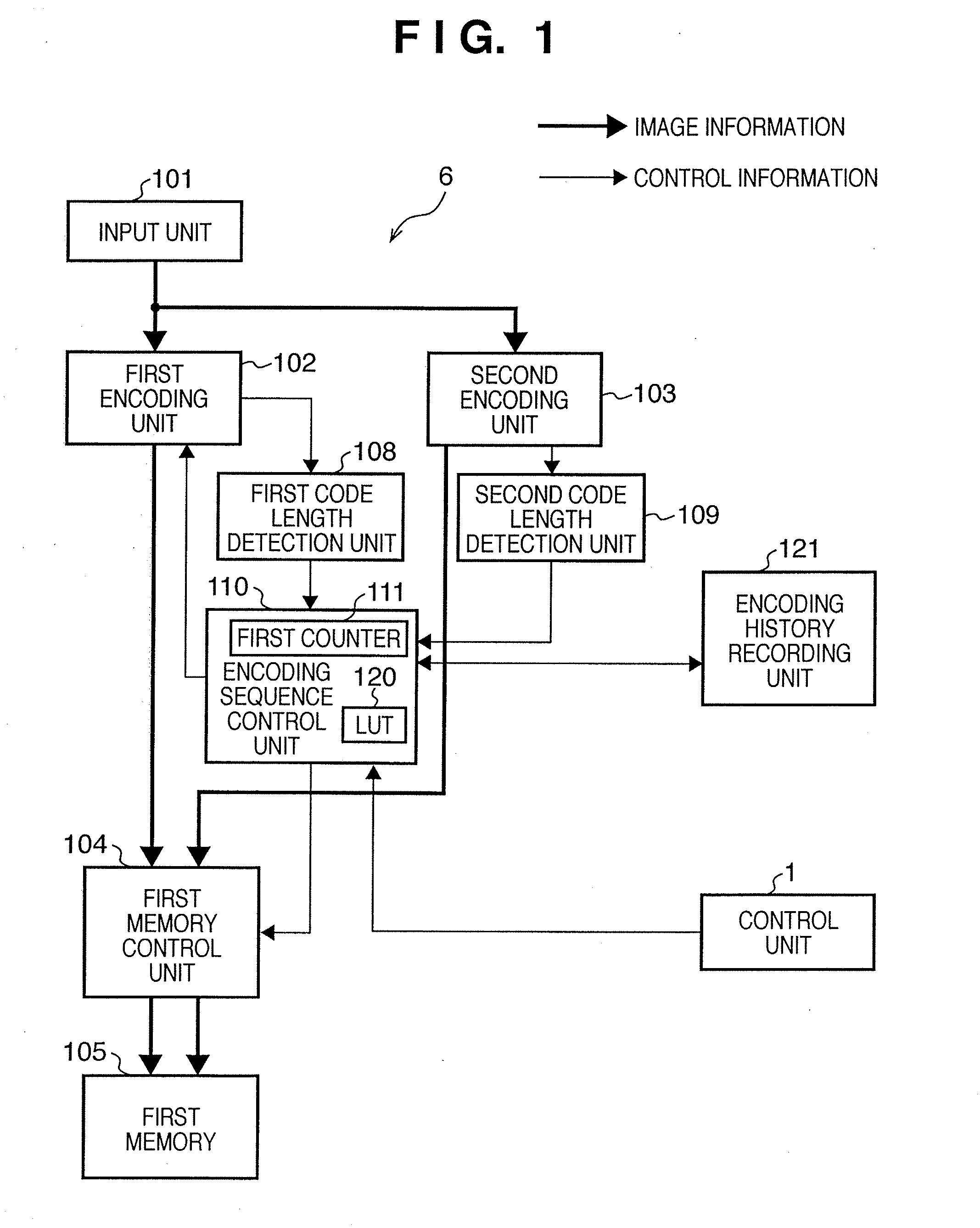Image encoding apparatus and method
a technology of image data and encoder, applied in the field of image data compressioncoding technique, can solve the problems of lossy process, image and natural image pose many problems, image and lossy process cannot guarantee high image quality for all kinds of images, etc., and achieve the effect of quick generation of encoded data and preventing any sense of discomfor
- Summary
- Abstract
- Description
- Claims
- Application Information
AI Technical Summary
Benefits of technology
Problems solved by technology
Method used
Image
Examples
second embodiment
[0192]In the above-described embodiment, when the encoded data amount (the value of the first counter 111) stored in the first memory 105 has exceeded the target code amount Th, the lossless encoded data amount MLS and lossy encoded data amount MJP in the encoded data are compared. The variables i and j of the next scanning are decided in accordance with the comparison result. In the second embodiment, an example of more accurate decision of variables i and j will be described.
[0193]Prior to the description, assume that when fi,j( ) changes to fi+1,j( ), a statistical decrement R((i,j),(i+1,j)) of the lossy encoded data length with respect to the pixel block is obtained. When fi,j( ) is used, the average lossy encoded data length of the pixel block is defined as C(fi,j( )). The decrement R((i,j),(i+1,j)) at this time is given by
R((i,j), (i+1,j) )=C(fi+1,j( )) / C(fi,j( ))
[0194]Similarly, assume that when fi,j( ) changes to fi,j+1( ) a statistical decrement R((i,j), (i,j+1) ) of the lo...
third embodiment
[0224]In the second embodiment, the predicted encoded data amounts Mtotal′, Mtotal″, and Mtotal′″ of one page are obtained, and re-encoding is executed by using encoding parameters corresponding to the data amount closest to the target code amount. In the third embodiment, an example will be described in which the encoding parameters are decided depending on the encoding target image. The apparatus arrangement is the same as in the first embodiment.
[0225]The structure of data stored in an encoding history recording unit 121 is the same as in the second embodiment. The predicted code amounts and predicted selection signals of lossy encoded data amount Ly are obtained in correspondence with all encoding parameters i and j.
[0226]FIGS. 25 to 27 show the boundary lines of boundary conditions fi,j( ) which are specified by the variables i (also serving as a variable to decide a quantization matrix Qi) and j stored in an LUT 120. FIGS. 25 to 27 illustrate an example of nine boundary lines ...
fourth embodiment
[0259]The fourth embodiment will be described. The fourth embodiment further advances the third embodiment. Details will be described below.
[0260]In the third embodiment, the coefficient β of inequality (4)
Mpz≦(MLSz+MJPz)×Nmax / k+β
is a positive value.
[0261]As can easily be seen from inequality (4), the larger the coefficient β is, the higher the probability to satisfy the condition is. Assume that the priority order shown in FIG. 25 is decided. If the value β is sufficiently large, the condition is immediately satisfied by the priority order P1, and re-scanning / re-encoding starts by using the encoding parameters i=1 and j=0.
[0262]In actual image data encoding, if the code amount decreases to a target code amount Th or less when the encoding parameters corresponding to a priority order P4 are used, scanning / encoding is executed five times in total on the basis of P0, P1, P2, P3, and P4. That is, when the coefficient β is set to a large value, it is possible to generate encoded data to...
PUM
 Login to View More
Login to View More Abstract
Description
Claims
Application Information
 Login to View More
Login to View More - R&D
- Intellectual Property
- Life Sciences
- Materials
- Tech Scout
- Unparalleled Data Quality
- Higher Quality Content
- 60% Fewer Hallucinations
Browse by: Latest US Patents, China's latest patents, Technical Efficacy Thesaurus, Application Domain, Technology Topic, Popular Technical Reports.
© 2025 PatSnap. All rights reserved.Legal|Privacy policy|Modern Slavery Act Transparency Statement|Sitemap|About US| Contact US: help@patsnap.com



